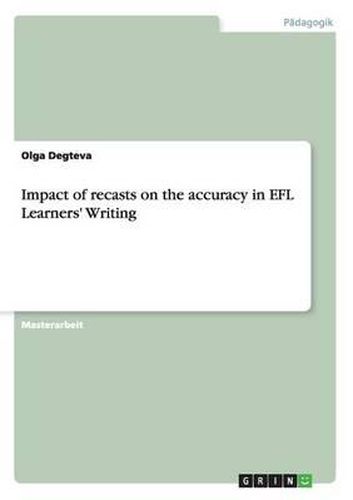Readings Newsletter
Become a Readings Member to make your shopping experience even easier.
Sign in or sign up for free!
You’re not far away from qualifying for FREE standard shipping within Australia
You’ve qualified for FREE standard shipping within Australia
The cart is loading…






Masterarbeit aus dem Jahr 2011 im Fachbereich Englisch - P dagogik, Didaktik, Sprachwissenschaft, Girne Amerikan niversitesi, Sprache: Deutsch, Abstract: Since the famous Truscott’s The case against grammar correction in L2 writing class (1996) there has been an ongoing debate in SLA research about the value of corrective feedback and its different forms. A growing number of empirical research is now investigating the question, and although more and more evidence is obtained against Truscott’s statement, there are still no definite conclusions about whether the feedback should be given, and if yes, in what form. The present study, designed as a longitudinal single-subject study with two participants, contributes to this research base, investigating one particular form of written corrective feedback - focused recast. During seven weeks thirteen written texts of each participant (first three served as a pre-test, the last one as a post-test) were given feedback in the form of focused recasts and then analysed for errors. All types of errors were targeted in the study. Also item-based and rule-based errors were considered separately to find out whether Ferris’s (2002) assumption about treatable and untreatable errors could be confirmed. The results showed significant decrease in the number of errors immediately after the baseline, and then steady downtrend throughout the treatment phase up to the post-test. The comparison of the pre-test and post-test scores let to conclude that recasts significantly assisted in increasing accuracy of writing. Quantitative analysis showed that the number of rule-based errors decreased more than the number of item-based errors. Qualitative analysis of the data of one of the participants showed, that item-based errors were treatable. It also brought up the suggestion that item-based features cannot be treated as a group. Each item is a single phenomenon which is not a part of any grammatical system of the language, and unlike rule-b
$9.00 standard shipping within Australia
FREE standard shipping within Australia for orders over $100.00
Express & International shipping calculated at checkout
Masterarbeit aus dem Jahr 2011 im Fachbereich Englisch - P dagogik, Didaktik, Sprachwissenschaft, Girne Amerikan niversitesi, Sprache: Deutsch, Abstract: Since the famous Truscott’s The case against grammar correction in L2 writing class (1996) there has been an ongoing debate in SLA research about the value of corrective feedback and its different forms. A growing number of empirical research is now investigating the question, and although more and more evidence is obtained against Truscott’s statement, there are still no definite conclusions about whether the feedback should be given, and if yes, in what form. The present study, designed as a longitudinal single-subject study with two participants, contributes to this research base, investigating one particular form of written corrective feedback - focused recast. During seven weeks thirteen written texts of each participant (first three served as a pre-test, the last one as a post-test) were given feedback in the form of focused recasts and then analysed for errors. All types of errors were targeted in the study. Also item-based and rule-based errors were considered separately to find out whether Ferris’s (2002) assumption about treatable and untreatable errors could be confirmed. The results showed significant decrease in the number of errors immediately after the baseline, and then steady downtrend throughout the treatment phase up to the post-test. The comparison of the pre-test and post-test scores let to conclude that recasts significantly assisted in increasing accuracy of writing. Quantitative analysis showed that the number of rule-based errors decreased more than the number of item-based errors. Qualitative analysis of the data of one of the participants showed, that item-based errors were treatable. It also brought up the suggestion that item-based features cannot be treated as a group. Each item is a single phenomenon which is not a part of any grammatical system of the language, and unlike rule-b